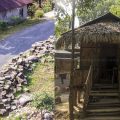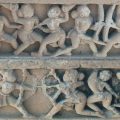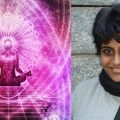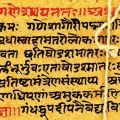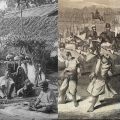Mattur: Sanskrit Speaking Village Where Ancient Meets Modern
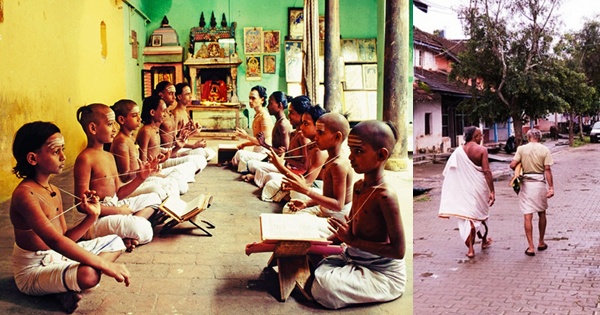
God’s own language Sanskrit is spoken here in day-to-day communications. Mattur in Shivamogga in Karnataka comprising of around 5,000 residents! Just step in here to feel the aura of the ancient in the modern. A walk in heritage, culture, and tradition of our ancient glorious past! The villagers here lead a Vedic lifestyle. They chant the ancient texts in Sanskrit. They speak this world’s oldest language fluently. Children here are taught the Vedas once they turn 10. This ancient language flourishes here like it was in Vedic times!
And yes, this small village situated across the bank of the Tunga River, thrives on the advancements of science and technology. The smooth roads, nature in bounty, cluster of concrete houses, lush fields of paddy, standing areca trees, smiling visages of the inhabitants will not differentiate it from any other flourishing villages of India. The Sanskrit graffiti, especially of ancient quotes, on the walls of the houses will bewilder you. It is no surprise if you spot many a youngster in white robes moving around on motorcycles! And don’t be mystified if you find them, clad in jeans and T-shirts, talking in Sanskrit over the latest iPhones or babble and laugh in Sanskrit in groups! Children playing cricket in the fields communicating aloud in Sanskrit and elders reciting Vedic hymns by the Tunga riverside are but common sights in Mattur.
Majority of the residents of Mattur are Sankethi Brahmins, who migrated from Kerala. Sanskrit runs in everyone’s veins. The Sankethi Brahmins also speak Sankethi, a rare dialect, which is a mixture of Sanskrit, Tamil, Kannada, and Telugu. This dialect has no written script. Devanagari is the script used for communication. Besides Sanskrit, the primary language and Sankethi, the villagers also speak in Kannada.
Signboards in Sanskrit at Mattur should not surprise you! In the current scenario where a tug-of-war ensues between the secular and non-secular fabric where any sign of Hindu or Vedic ritual in public is coined as ‘communal’, a Mattur village school proudly displays a giant statue of goddess Saraswati at the centre of its courtyard.
Mattur has a temple of Rama, a Shivalaya, Someshwara temple and Lakshmikeshava temple. At the village schools, the Vedas are chanted in the traditional way. Besides learning the Vedas and other ancient scriptures as part of a course, students also learn English and Kannada. Preserving of damaged text available in ancient palm leaves is an initiative that the students of Mattur have started. They collect old Sanskrit palm leaves, copy the script language in computers, and rewrite the damaged text in present day Sanskrit. Besides, they make it available in the form of publications. Students from other regions of India and abroad attend Sanskrit courses including crash courses in Mattur to learn the language.
Learning Sanskrit has helped students develop an aptitude for Maths and logic. Students grow up learning in the schools of Mattur to become engineers, doctors, entrepreneurs, and pursue other vocations. No wonder this village has one of the highest number of IT professionals, at least one from each family! Sanskrit professors from Mattur have been teaching in prestigious universities.
Residents of Mattur have taken extra efforts to support and preserve the Gamaka, also termed kaavya vaachana, a unique form of singing and storytelling in Karnataka. The storytelling involves reading a stanza of a poem, sourced from the epics. Highest emphasis is laid on meaning and the storyteller applies suitable raga or a melodic line. There is no established rhythm; the melody and raga is randomly picked from Kannada folk tunes and Carnatic music, matching the emotions of the stanza. Another person then explains the meaning of the stanza drawing examples and anecdotes. Stanza after stanza, the singer splits compound words using raga and melody, making it easier for listeners to understand while the other narrates accordingly. H.R. Keshavamurthy is a renowned Gamaka exponent from Mattur.
Many of the IT professionals from Mattur are working abroad and across India in top corporate houses. But when it comes to rituals and festivals, they make it a point to attend, back home. According to an Economic Times report, not a single property dispute is pending before courts from this village. And the crime rate is extremely low; the villagers consider themselves as one extended family.
Mattur’s twin village, Hosahalli, also located across the bank of the Tunga River, shares almost all the qualities of Mattur. Few more villages in India where Sanskrit is spoken to a great extent are Sasana in Orissa and Jhiri, Mohad, and Baghuwar in Madhya Pradesh. More regions across India should adopt Sanskrit as one of the spoken languages. The Sanskrit renaissance cannot happen unless this subject is taught in every school. Revival of our ancient language should happen at the grassroots level across India. Thanks to the Narendra Modi government planning to replace German with Sanskrit in CBSE schools.
Featured image courtesy: VoxSpace and Namma Shivamogga
Ref:
1. economictimes.indiatimes.com/news/politics-and-nation/karnatakas-mattur-a-sanskrit-speaking-village-with-almost-one-it-professional-per-family/articleshow/45242528.cms
2. “Sanskrit village set to glow anew – Times of India”. Retrieved 25 November 2016.
3. http://www.swarasindhu.in/swarasindhu/showDetails.do?table=Artist&id=117

